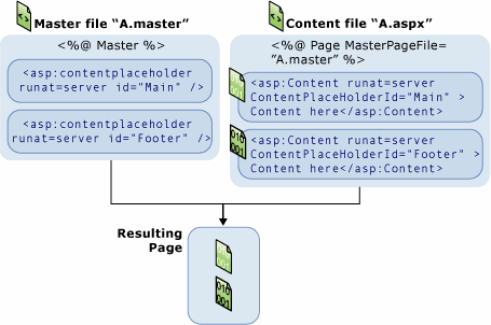Master Page在运行时的行为
At run time, master pages are handled in the following sequence:
-
Users request a page by typing the URL of the content page.
-
When the page is fetched, the @ Page directive is read. If the directive references a master page, the master page is read as well. If this is the first time the pages have been requested, both pages are compiled.
-
The master page with the updated content is merged into the control tree of the content page.
-
The content of individual Content controls is merged into the corresponding ContentPlaceHolder control in the master page.
-
The resulting merged page is rendered to the browser.
The process is illustrated in the following diagram.
Master pages at run time

From the user's perspective, the combined master and content pages are a single, discrete page. The URL of the page is that of the content page.
From a programming perspective, the two pages act as separate containers for their respective controls. The content page acts as a container for the master page. However, you can reference public master-page members from code in the content page, as described in the next section.
Note that the master page becomes a part of the content page. In effect, the master page acts in much the same way a user control acts — as a child of the content page and as a container within that page
来源:
Run-time Behavior of Master Pages
http://msdn.microsoft.com/en-us/library/wtxbf3hh.aspx#RunTimeBehaviorOfMasterPages



【推荐】国内首个AI IDE,深度理解中文开发场景,立即下载体验Trae
【推荐】编程新体验,更懂你的AI,立即体验豆包MarsCode编程助手
【推荐】抖音旗下AI助手豆包,你的智能百科全书,全免费不限次数
【推荐】轻量又高性能的 SSH 工具 IShell:AI 加持,快人一步
· AI与.NET技术实操系列:向量存储与相似性搜索在 .NET 中的实现
· 基于Microsoft.Extensions.AI核心库实现RAG应用
· Linux系列:如何用heaptrack跟踪.NET程序的非托管内存泄露
· 开发者必知的日志记录最佳实践
· SQL Server 2025 AI相关能力初探
· 震惊!C++程序真的从main开始吗?99%的程序员都答错了
· 【硬核科普】Trae如何「偷看」你的代码?零基础破解AI编程运行原理
· 单元测试从入门到精通
· 上周热点回顾(3.3-3.9)
· winform 绘制太阳,地球,月球 运作规律